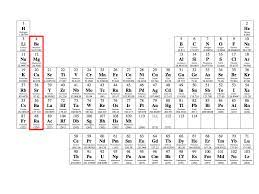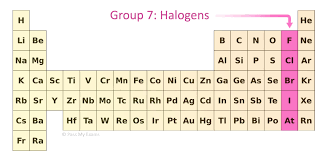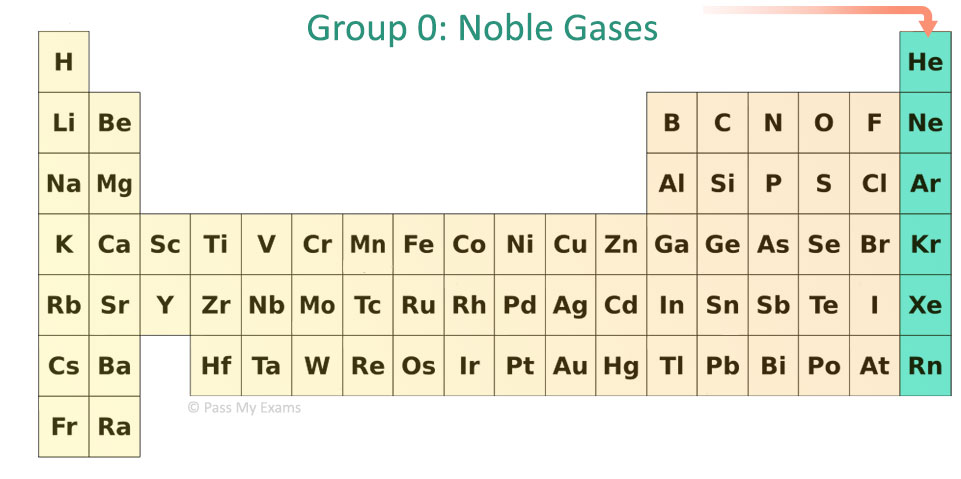
Chapter 4: Group Elements
4.1-Metals and Non-Metals
Most elements are metals
Metals are elements which can for positive ions when they react
They’re towards the bottom and to the left of the periodic table
Most elements in the periodic table are metals
Non-metals are at the far right and top of the periodic table
Non-metals don’t generally form positive ions when they react
The electronic structure of atoms affects how they will react
Atoms generally react to form a full outer shell
They do this via losing, gaining or sharing electrons
Metals to the left of the periodic table don’t have many electrons to remove
Metals towards the bottom of the periodic table have outer electrons which are a long way from the nucleus
They feel a weaker attraction
Both these effects means that not much energy is needed to remove the electrons so it’s feasible for them to either share or gain electrons to get a full outer shell
Metals and non-metals have different physical properties
All metals have metallic bonding which causes them to have similar basic physical properties
They’re strong but can be bent or hammered into different shapes
They’re great at conducting heat and electricity
They have high boiling and melting points
As non-metals don’t have metallic bonding, they don’t tend to exhibit the same properties as metals
They tend to be dull looking, more brittle, aren’t always solids at room temperature, don’t generally conduct electricity, and often have a lower density
Transition metals can be found between group 2 and group 3
Transition metals are in the centre of the periodic table
Transition metals are typical metals and have the properties you would expect of a proper metal
They’re good conductors or heat and electricity and they’re very dense, strong and shiny
Transition metals also have some pretty special properties
Transition metals can have more than one iron
Copper forms Cu+ and Cu2+ ions
Cobalt forms Co2+ and Co3+ ions
Transition metal ions are often coloured, and so compounds that contain them are colourful
Potassium chromate which yellow and potassium manganate is purple
Transition metal compounds often make good catalysts
Nickel based catalysts are used in the hydrogenation of alkenes
Iron catalyst is used in the haber process for making ammonia

4.2-Group 1 Elements
The group 1 elements are reactive, soft metals

The alkali metals are lithium, sodium, potassium, rubidium, caesium and francium
They all have one electron in their outer shell which makes them very reactive and gives them similar properties
The alkali metals are all soft and have low density
The trends for the alkali metals as you go down Group 1 include:
Increasing reactivity
The outer electron is more easily lost as the attraction between the nucleus and electron decreases, because the electron is further away from the nucleus and the further down the group you go
Lower melting and boiling points
Higher relative atomic mass
Alkali metals form ionic compounds with non-metals
The Group 1 elements don’t need much energy to lose their one outer electron to form a full outer shell, so they readily form 1+ ions
It’s so easy for them to lose their outer electron that they only ever react to form ionic compounds.
These compounds are generally white solids that dissolve in water to form colourless solutions
Reaction with water
When Group 1 metals are put in water, they react vigorously to produce hydrogen gas and metal hydroxide
Salts that dissolve in water to produce alkaline solutions
The more reactive(lower down in the group) an alkali metal is, the more violent the reaction
Sodium + Water - Sodium Hydroxide + Hydrogen
2Na + 2H20 - 2NaOH + H
Reaction with chlorine
Group 1 metals react vigorously when heated in chlorine gas to form white chloride salts
As you go down the group, reactivity increases so the reaction with chlorine gets more vigorous
Sodium + Chlorine - Sodium Chloride
2Na + Cl - 2NaCl
Reaction with oxygen
The Group 1 metals can react with oxygen to form a metal oxide:
Different types of oxide will form depending on the Group 1 metal:
Lithium reacts to form lithium oxide
Sodium reacts to form a mixture of sodium oxide(Na20) and sodium peroxide(Na2O2)
Potassium reacts to form a mixture of potassium peroxide(K202) and potassium superoxide(K02)
Group 1 metals have different properties to transition metals
Group 1 metals are much more reactive than transition metals-they react more vigorously with water, oxygen or Group 7 elements, for example
They’re also much less dense, strong and hard than the transition metals, and have much lower melting points
e.g. manganese melts at 2000C
Sodium melts at 98C
4.3-Group 7 Elements
The halogens are all non-metals with coloured vapours
Fluorine is a very reactive, poisonous yellow gas
Chlorine is a fairly reactive, poisonous dense green gas
Bromine is a dense, poisonous red-brown volatile liquid
Iodine is a dark grey crystalline solid or a purple vapour
They all exist as molecules which are pairs of atoms

Learn these trends
As you go down Group 7 the halogens
Become less reactive
It’s harder to gain an extra electron, because the outer shell’s further from the nucleus
Have higher melting and boiling points
Have higher relative atomic mass
All the Group 7 elements react in similar ways.
This is because they all have seven electrons in their outer shell
Halogens can form molecular compounds
Halogen atoms can share electrons via covalent bonding with other non-metals so as to achieve a full outer shell
For example, HCI, PCI5, HF and CCI4 contain covalent bonds
The compounds that form when halogens react with non-metals all have simple molecular structures
Halogens form ionic bonds with metals
The halogens from 1-ions called halides
F-, CI-, Br- and I-
When they bond with metals
Na+Ci or Fe3+Br-3
The compounds that form have ionic structures
The diagram shows the bonding in sodium chloride, NaCI
More reactive halogens will displace less reactive ones
A displacement reaction can occur between a more reactive halogen and the salt of a less reactive one
E.g. Chlorine can displace bromine and iodine form an aqueous solution of its salt(a bromine or iodine)
Bromine will also displace iodine because of the trend in reactivity
Cl2 + 2KI - I2 + 2KCI
Pale green - Brown
CL2 + 2KBr - Br2 + 2KCI
Pale green - Orange
4.4-Group 0 Elements
Group 0 elements are all inert, colourless gases
Group 0 elements are called the noble gases and include the elements helium, neon and argon(and a few others)
They all have eight electrons in their outer energy level, apart from helium which has two, giving them a full outer shell
As their outer shell is energetically stable they don’t need to give up or gain electrons to become more stable
This means they are more or less inert-they don’t react with much at all
They exist as monatomic gases-single atoms not bonded to each other
All elements in Group 0 are colourless gases at room temperature
As the noble gases are inert they’re non flammable
They won’t set on fire

There are patterns in the properties of the noble gases
The boiling point of the noble gases increase as you move down the group along with increasing relative atomic mass
The increase in boiling point is due to an increase in the number of electrons in each atom leading to greater intermolecular forces between them which need to be overcome
In the exam you may be given the boiling point of one noble gas and asked to estimate the value for another one
Neon is a gas at 25C. Predict what state helium is at this temperature
Helium has a lower boiling point than neon as it is further up the group
So, Helium must also be a gas at 25C
Chapter 4: Group Elements
4.1-Metals and Non-Metals
Most elements are metals
Metals are elements which can for positive ions when they react
They’re towards the bottom and to the left of the periodic table
Most elements in the periodic table are metals
Non-metals are at the far right and top of the periodic table
Non-metals don’t generally form positive ions when they react
The electronic structure of atoms affects how they will react
Atoms generally react to form a full outer shell
They do this via losing, gaining or sharing electrons
Metals to the left of the periodic table don’t have many electrons to remove
Metals towards the bottom of the periodic table have outer electrons which are a long way from the nucleus
They feel a weaker attraction
Both these effects means that not much energy is needed to remove the electrons so it’s feasible for them to either share or gain electrons to get a full outer shell
Metals and non-metals have different physical properties
All metals have metallic bonding which causes them to have similar basic physical properties
They’re strong but can be bent or hammered into different shapes
They’re great at conducting heat and electricity
They have high boiling and melting points
As non-metals don’t have metallic bonding, they don’t tend to exhibit the same properties as metals
They tend to be dull looking, more brittle, aren’t always solids at room temperature, don’t generally conduct electricity, and often have a lower density
Transition metals can be found between group 2 and group 3
Transition metals are in the centre of the periodic table
Transition metals are typical metals and have the properties you would expect of a proper metal
They’re good conductors or heat and electricity and they’re very dense, strong and shiny
Transition metals also have some pretty special properties
Transition metals can have more than one iron
Copper forms Cu+ and Cu2+ ions
Cobalt forms Co2+ and Co3+ ions
Transition metal ions are often coloured, and so compounds that contain them are colourful
Potassium chromate which yellow and potassium manganate is purple
Transition metal compounds often make good catalysts
Nickel based catalysts are used in the hydrogenation of alkenes
Iron catalyst is used in the haber process for making ammonia

4.2-Group 1 Elements
The group 1 elements are reactive, soft metals

The alkali metals are lithium, sodium, potassium, rubidium, caesium and francium
They all have one electron in their outer shell which makes them very reactive and gives them similar properties
The alkali metals are all soft and have low density
The trends for the alkali metals as you go down Group 1 include:
Increasing reactivity
The outer electron is more easily lost as the attraction between the nucleus and electron decreases, because the electron is further away from the nucleus and the further down the group you go
Lower melting and boiling points
Higher relative atomic mass
Alkali metals form ionic compounds with non-metals
The Group 1 elements don’t need much energy to lose their one outer electron to form a full outer shell, so they readily form 1+ ions
It’s so easy for them to lose their outer electron that they only ever react to form ionic compounds.
These compounds are generally white solids that dissolve in water to form colourless solutions
Reaction with water
When Group 1 metals are put in water, they react vigorously to produce hydrogen gas and metal hydroxide
Salts that dissolve in water to produce alkaline solutions
The more reactive(lower down in the group) an alkali metal is, the more violent the reaction
Sodium + Water - Sodium Hydroxide + Hydrogen
2Na + 2H20 - 2NaOH + H
Reaction with chlorine
Group 1 metals react vigorously when heated in chlorine gas to form white chloride salts
As you go down the group, reactivity increases so the reaction with chlorine gets more vigorous
Sodium + Chlorine - Sodium Chloride
2Na + Cl - 2NaCl
Reaction with oxygen
The Group 1 metals can react with oxygen to form a metal oxide:
Different types of oxide will form depending on the Group 1 metal:
Lithium reacts to form lithium oxide
Sodium reacts to form a mixture of sodium oxide(Na20) and sodium peroxide(Na2O2)
Potassium reacts to form a mixture of potassium peroxide(K202) and potassium superoxide(K02)
Group 1 metals have different properties to transition metals
Group 1 metals are much more reactive than transition metals-they react more vigorously with water, oxygen or Group 7 elements, for example
They’re also much less dense, strong and hard than the transition metals, and have much lower melting points
e.g. manganese melts at 2000C
Sodium melts at 98C
4.3-Group 7 Elements
The halogens are all non-metals with coloured vapours
Fluorine is a very reactive, poisonous yellow gas
Chlorine is a fairly reactive, poisonous dense green gas
Bromine is a dense, poisonous red-brown volatile liquid
Iodine is a dark grey crystalline solid or a purple vapour
They all exist as molecules which are pairs of atoms

Learn these trends
As you go down Group 7 the halogens
Become less reactive
It’s harder to gain an extra electron, because the outer shell’s further from the nucleus
Have higher melting and boiling points
Have higher relative atomic mass
All the Group 7 elements react in similar ways.
This is because they all have seven electrons in their outer shell
Halogens can form molecular compounds
Halogen atoms can share electrons via covalent bonding with other non-metals so as to achieve a full outer shell
For example, HCI, PCI5, HF and CCI4 contain covalent bonds
The compounds that form when halogens react with non-metals all have simple molecular structures
Halogens form ionic bonds with metals
The halogens from 1-ions called halides
F-, CI-, Br- and I-
When they bond with metals
Na+Ci or Fe3+Br-3
The compounds that form have ionic structures
The diagram shows the bonding in sodium chloride, NaCI
More reactive halogens will displace less reactive ones
A displacement reaction can occur between a more reactive halogen and the salt of a less reactive one
E.g. Chlorine can displace bromine and iodine form an aqueous solution of its salt(a bromine or iodine)
Bromine will also displace iodine because of the trend in reactivity
Cl2 + 2KI - I2 + 2KCI
Pale green - Brown
CL2 + 2KBr - Br2 + 2KCI
Pale green - Orange
4.4-Group 0 Elements
Group 0 elements are all inert, colourless gases
Group 0 elements are called the noble gases and include the elements helium, neon and argon(and a few others)
They all have eight electrons in their outer energy level, apart from helium which has two, giving them a full outer shell
As their outer shell is energetically stable they don’t need to give up or gain electrons to become more stable
This means they are more or less inert-they don’t react with much at all
They exist as monatomic gases-single atoms not bonded to each other
All elements in Group 0 are colourless gases at room temperature
As the noble gases are inert they’re non flammable
They won’t set on fire

There are patterns in the properties of the noble gases
The boiling point of the noble gases increase as you move down the group along with increasing relative atomic mass
The increase in boiling point is due to an increase in the number of electrons in each atom leading to greater intermolecular forces between them which need to be overcome
In the exam you may be given the boiling point of one noble gas and asked to estimate the value for another one
Neon is a gas at 25C. Predict what state helium is at this temperature
Helium has a lower boiling point than neon as it is further up the group
So, Helium must also be a gas at 25C
 Knowt
Knowt
